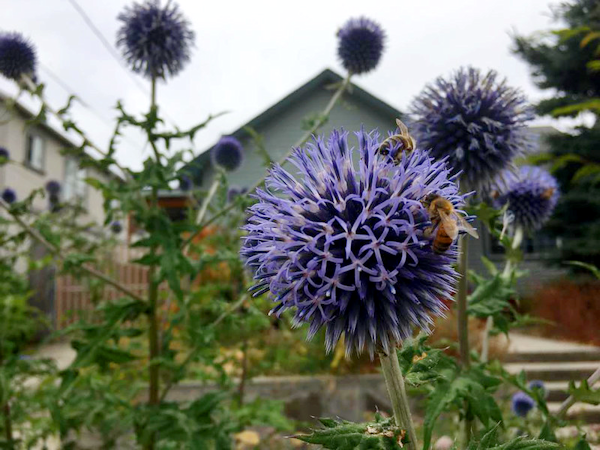SEJournal Online is the digital news magazine of the Society of Environmental Journalists. Learn more about SEJournal Online, including submission, subscription and advertising information.
 |
 |
| Unlike a grass lawn, a pollinator garden is rich in plants that attract and support pollinators, like the bees above, or butterflies, birds and bats. Photo: Oregon Department of Agriculture via Flickr Creative Commons (CC BY-NC-ND 2.0). |
TipSheet: Eco-Alternatives to the Perfect, Weedless Lawn
By Joseph A. Davis
Is that yard a sweaty chore or a Garden of Eden?
No matter where environmental journalists live, they may find a lot to report about just by focusing on what people do (or don’t do … or can’t do) with their yards. TipSheet has ideas.
First off, it matters. Not only does the perfect green lawn require laborious mowing — and watering, and fertilizer, and weed killers and bug killers. But a lot of those chemicals may run off the lawn and into water bodies where they may do harm.
Let’s be real:
Green lawns are
anything but natural.
And let’s be real: Green lawns are anything but natural. There is evidence that the lawn as we know it was invented by European aristocrats after the Middle Ages. Louis XIV put in a lawn at Versailles. Lawns were a form of conspicuous nonconsumption meant to display power, wealth and status. Or at least some people say.
‘Lawn police’ rebels?
Today, instead of absolute monarchs, we have homeowner associations, zoning laws and other forms of governance that put limits on what people can do with their lawns, besides some kind of high-maintenance, chemical-based monoculture. Just check with the local HOAs.
So ask, are any of your neighbors rebelling against the “lawn police”? That might be a story. Can you keep bees or raise chickens? What does that mean for the turf?
Sometimes the streetward side of a yard may be a municipal easement, rather than the owner’s property. This can sometimes spark conflict, too.
Story ideas
What else people might want to do with their yards will depend on lots of factors, ranging from personal taste to geographic location. Here are some types of lawns that can bring story ideas.
- Wildlife habitats: Birds and bunnies actually are signs of a healthy ecosystem. The National Wildlife Federation even certifies yards that optimize wildlife food, water, cover, places to rear young and sustainability.
- Pollinator gardens: A garden can be rich in certain plants that attract and support pollinators. Pollinators may include bees, butterflies and other insects — as well as birds and even bats.
- Butterfly gardens: Butterflies are fascinating and beautiful, but they also serve as pollinators and require our help. Of course, everyone thinks immediately of endangered monarchs. Could you recognize much-needed milkweed and butterfly weed?
- Native gardens: Not only do plants that are native to a particular area grow better there, but they often mesh better with other native plants and animals. Even when they are not as showy as the fashionable favorites.
- Bird centers: Birds and gardens need each other. Sometimes plants are better for birds than feeders (which can spread disease). Robins will help show whether your worms are healthy. You may see hungry flocks of robins strip a holly tree bare of berries in the winter.
- Vegetable gardens: If the neighbors can stand it, vegetable gardens are a truly eco-friendly way to plant your yard. It’s good to have (or build) quality soil to a significant depth, and to test it for lead and other bad things. Also, you have to weed them. But pests can be controlled with mechanical barriers, rather than chemicals. Perennials like asparagus. rhubarb or herbs may be easier.
- Xeriscapes: Many homeowners, especially in arid areas, minimize the need for irrigation (and maintenance) with gravel beds, cacti, succulents, etc. Think drought-tolerant perennials. Any near you?
Reporting resources
- National Wildlife Federation: A national membership organization for wildlife conservation. It has local chapters. And it is the one to certify home yard wildlife habitats.
- Xerces Society: A broad group whose membership includes scientists and landscape managers, and is devoted to invertebrate conservation. It has pollinator-friendly plant lists by region.
- Local nurseries: Gardeners visit these local treasures often. Talk to senior staff.
- County extension: All-purpose helpers with expertise. Here is a good directory.
- Ecological Landscape Alliance: A professional organization whose members include landscape architects and others. Its directory is a gold mine.
- Planning and zoning boards: They usually have lots of staff. They can help you find out what’s legal in your area.
- Garden clubs: There is likely one in your neighborhood. Go to a meeting. And bring cookies.
[Editor's Note: Also see this TipSheet on covering the use of lawn chemicals.]
Joseph A. Davis is a freelance writer/editor in Washington, D.C. who has been writing about the environment since 1976. He writes SEJournal Online's TipSheet, Reporter's Toolbox and Issue Backgrounder, and curates SEJ's weekday news headlines service EJToday and @EJTodayNews. Davis also directs SEJ's Freedom of Information Project and writes the WatchDog opinion column.
* From the weekly news magazine SEJournal Online, Vol. 9, No. 32. Content from each new issue of SEJournal Online is available to the public via the SEJournal Online main page. Subscribe to the e-newsletter here. And see past issues of the SEJournal archived here.













 Advertisement
Advertisement 



